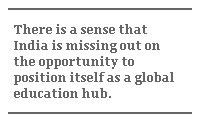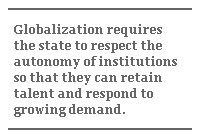Outsourcing of Indian Education
Outsourcing of Indian Education

NEW DELHI: In many breathless foreign reports about India’s outsourcing clout, the nation’s education often gets high marks for being the source of so much success. But the reality is that – while in absolute numbers, with a population of a billion plus, the country is ahead of others with total graduates – Indian higher education is not responding to the challenges posed by globalization.
The challenge facing India was recently on display when resident doctors and students at a premier medical school in New Delhi went on a lengthy strike. The protest targeted the government’s plan to extend existing affirmative-action admission quotas for disadvantaged castes an extra 27 percent, up from 22.5 percent. Neither the quotas nor protests are new. Indian institutions already have an extensive series of quotas for different castes. This proposal sought to extend quotas for new groups in India’s most prized institutions: the All India Institute of Medical Sciences, the famous Indian Institute of Technology (IIT) and the Indian Institute of Management. Aside from the familiar questions about the effectiveness of quotas and their impact on quality of education, the protest and the ensuing debate have put in sharper focus major challenges that globalization poses to India’s system of higher education.

Globalization poses many challenges for higher education. Countries struggle with the fact that the market for talent has become global. India’s premier institutions are hampered by the fact that incentive structures to retain good faculty simply do not exist. Premier institutions like IIT and the Delhi School of Economics confront faculty shortages up to 40 percent, and their research profile is nowhere commensurate with their possibilities. India has become a net consumer of foreign education – spending to the tune of $3 billion a year to train students abroad.
However, the Indian education system is not able to mobilize funds from its students at home. By some accounts, Indian students, whose fees are paid by their parents, have become a net subsidizer of British higher education; the largest number of foreign students in the US come from India, some 80,000; and there are even an estimated 5,000 Indian medical students in China. Many of the best students go abroad. One measure of the price India has paid for the flight of intellectual capital is this: Devesh Kapur of the University of Texas has calculated that for every patent held by an Indian, Indians abroad hold 28,000 patents!
Second, globalization has made benchmarking in education global. While India’s premier institutions are good feeder schools for institutions abroad because of their recruitment process, their ability to compete globally is still an open question. Only three Indian institutions rank among the top 500 in the world, and significantly none of them are full-fledged universities. Beyond a small group of elite institutions, few Indian institutions are globally accredited or recognized. Thus, the competition for a handful of elite institutions is severe.

Third, globalization has made education an extraordinary business opportunity with a great impact on employment. While there is some R&D outsourcing to India, there is also the sense that India is missing out on the opportunity to position itself as a global education hub. Its share in the global higher-education market is miniscule, and there are significantly more foreign students in China than in India. According to a study by the Association of Indian Universities of 300 universities, the number of foreign students in India shrunk from 12,765 during the 1992-93 academic year to 7,745 in 2003-04.
Fourth, the ability of an economy to compete depends on the character of its education system. India has historically neglected primary and secondary education. But even in higher education, the nation faces severe shortages of talent. Reports from almost every sector of the economy, from health to aviation engineering, forecast shortages of skilled personnel. While in aggregate, the mismatch does not appear stark, there are severe bottlenecks in some sectors. The cost to business is increased by the fact that firms must do much of their training in-house, since they cannot count on the supply of talent. The mismatch of education to the economy is also evidenced in this paradox: While there is a severe shortage of skilled manpower, a third of unemployed youth are science graduates. The government has promised to increase outlays in higher education, mostly to allay some of the fears of the striking students that the number of non-quota seats will be drastically reduced. But government-determined allocations are not necessarily sensitive to the needs of the economy.

The four challenges of globalization – the flight of talent, benchmarking to global standards, the possibility of education as a business opportunity, and the mismatch between supply and demand – have a common thread running through them. Inflexible and overtly regulated education systems are unlikely to respond to these challenges. Rigid academic systems all over world, in Germany for example, struggle to reposition themselves to respond to the challenges posed by globalization. The Indian regulatory system is very much modeled on central planning. It assumes that regulatory agencies can second guess the sectors where demand is likely as well as the appropriate content of education. Ironically, India met some demands of the IT sector, because a large number of private institutions managed to dodge the regulatory system by offering diplomas rather than degrees – which can only be conferred by government-regulated institutions.
The Indian education system is one of the most tightly controlled in the world. The government regulates who you can teach, what you can teach them and what you can charge them. It also has huge regulatory bottlenecks. There are considerable entry barriers: Universities can be set up only through acts of legislation, approval procedures for starting new courses are cumbersome, syllabi revision is slow, and accreditation systems are extremely weak and arbitrary. The regulators permit relatively little autonomy for institutions and variation amongst them.

Over-regulation has produced the crisis of higher education that is the context of the current agitation. The shortage of quality institutions is a product of India’s regulatory structures. Increased public investment that the government has promised is absolutely necessary to increase access. But this investment will not yield much if India’s regulatory regime remains rigid. There was agitation over quotas not because the students oppose increased access or even affirmative action. Quotas became a symbol of the state’s power over Indian education: its propensity to hoist its own purposes upon academic institutions regardless of their impact on the quality of these institutions. Globalization requires two contradictory transformations in the state: On the one hand, successful globalization requires that the state invest heavily in increasing access to education. But in higher education, globalization also requires the state to respect the autonomy of institutions so that a diversity of experiments can find expression, so that institutions have the flexibility to do what it takes to retain talent in a globalized world and, above all, respond quickly to growing demand. Globalization demands a paradigm shift in the regulation of higher education. In India the debate has only just begun.
Pratap Bhanu Mehta is president of the Center for Policy Research in Delhi, India.